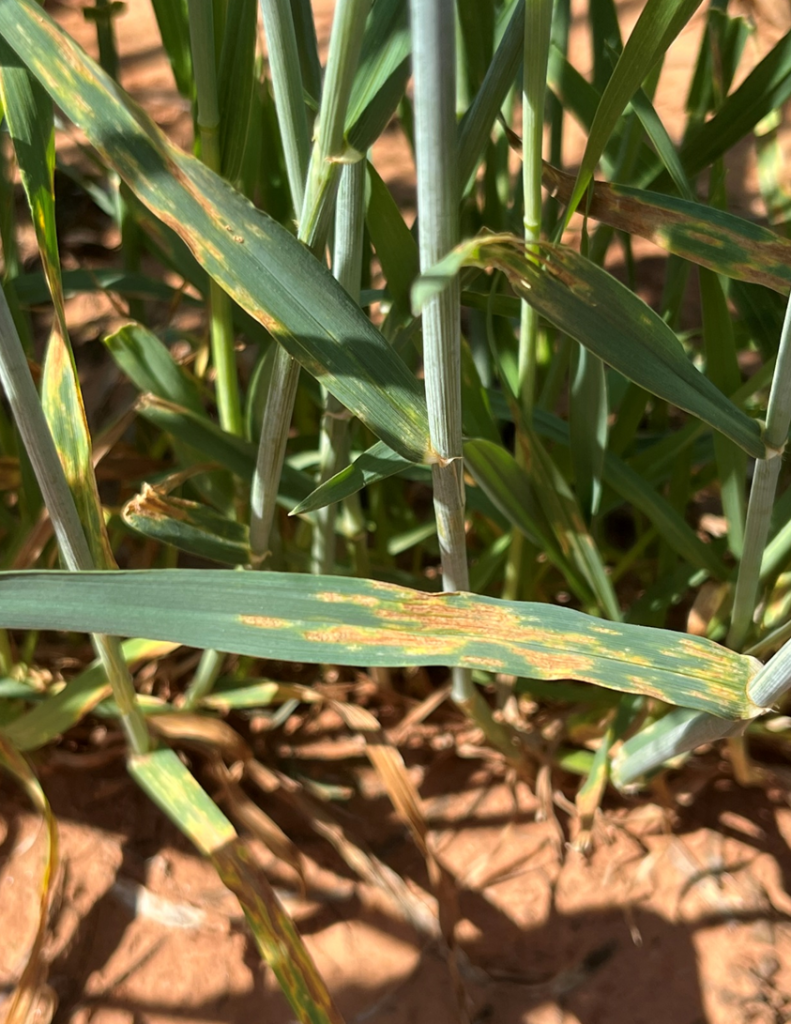Wheat Disease Update – April 28, 2025
Meriem Aoun, Small Grains Pathologist
Department of Entomology & Plant Pathology, Oklahoma State University
In April, wheat streak mosaic (WSM) was observed in Blaine, Kay, Caddo, and Garfield counties. This follows earlier reports of WSM in Garfield and Payne counties from my March update. Samples from these locations were confirmed to be infected with wheat streak mosaic virus (WSMV) by the OSU Plant Disease and Insect Diagnostic Lab.
On April 28, Dr. Brett Carver reported high levels of WSM (Figure 1) at the OSU North Central Research Station in Lahoma. The varieties showing the most severe symptoms in Lahoma were Gallagher, Paradox, and Turret 25. WSMV is transmitted by the wheat curl mite, which oversummers on volunteer wheat and grassy weeds. Destroying volunteer wheat and grassy weeds at least two weeks prior to planting is effective in managing this disease.
 Figure 1. Wheat streak mosaic symptoms (OSU North Central Research Station in Lahoma, photo credit: Dr. Brett Carver, 28 April 2025).
Figure 1. Wheat streak mosaic symptoms (OSU North Central Research Station in Lahoma, photo credit: Dr. Brett Carver, 28 April 2025).
The rainfall during the second half of April favored the development of tan spot and septoria tritici blotch on lower leaves. Tan spot (Figures 2 and 3) was observed in a wheat field in Blaine County and Septoria tritici blotch (Figure 4) was observed at the OSU research stations in Stillwater (Payne County) and Chickasha (Grady County). Septoria tritici blotch and tan spot are fungal diseases of wheat that become more prevalent with the adoption of no-till or reduced-till practices that leave wheat residue on the soil surface. To help manage these diseases, growers are encouraged to avoid planting varieties that are highly susceptible.
 Figure 2. Tan spot lesions on wheat leaves collected in a grower’s field at Blaine County (23 April 2025).
Figure 2. Tan spot lesions on wheat leaves collected in a grower’s field at Blaine County (23 April 2025).
 Figure 3. Dark reproductive structures on wheat stems produced by the tan spot fungus (Blaine County, 23 April 2025).
Figure 3. Dark reproductive structures on wheat stems produced by the tan spot fungus (Blaine County, 23 April 2025).
 Figure 4. Lesions of septoria tritici blotch on lower leaves (Stillwater, OK; 23 April 2025).
Figure 4. Lesions of septoria tritici blotch on lower leaves (Stillwater, OK; 23 April 2025).
Lastly, on 21 April, trace levels of stripe rust were observed in Walters (Cotton Country) in Southwest Oklahoma. To date, there have been no observations of leaf rust in Oklahoma this season.
Wheat Disease Update – 1 April 2025
Meriem Aoun
Small Grains Pathologist
Department of Entomology & Plant Pathology Oklahoma State University
Disease pressure in Oklahoma remained low throughout March 2025. However, symptoms of wheat soilborne mosaic virus (WSBMV) and wheat spindle streak mosaic virus (WSSMV) were observed at two locations: the OSU Entomology and Plant Pathology farm in Stillwater and the OSU North Central Research Station in Lahoma (Garfield County) around the second week of March (Figure 1). Once a field is infected with WSBMV, the only effective management strategy is planting resistant varieties. Fortunately, most hard winter wheat varieties in the Great Plains are resistant to this virus. WSSMV can co-infect alongside WSBMV but is generally less damaging and less widespread in Oklahoma. A few varieties are resistant to wheat soil-borne mosaic but susceptible to wheat spindle streak mosaic.
On March 14, 2025, a wheat sample from a grower’s field in Garber (Garfield County) tested positive for both WSBMV and wheat streak mosaic virus (WSMV). WSMV is spread by the wheat curl mites, which oversummer on alternative hosts like corn, volunteer wheat, and grassy weeds. Because wheat curl mites have a short lifespan (7–10 days), the best strategy for managing WSMV is to make sure that these alternative hosts are completely dead at least two weeks prior to wheat planting. A few wheat varieties, including the OSU variety ‘Breakthrough’, are resistant to WSMV.
 Figure 1. Wheat showing yellowing and stunting was infected with wheat soilborne mosaic virus (Lahoma, OK; 11 March 2025. Photo Credit: Brett Carver).
Figure 1. Wheat showing yellowing and stunting was infected with wheat soilborne mosaic virus (Lahoma, OK; 11 March 2025. Photo Credit: Brett Carver).
No stripe rust or leaf rust has been observed or reported in Oklahoma so far. However, rust infections have been observed in Texas as early as February 26. Brandon Gerrish (Assistant Professor & Extension Specialist, Texas A&M University) reported low levels of leaf and stripe rust in wheat plots in College Station on February 26. Tyler Mays (IPM-Hill County) reported trace levels of stripe rust north of Waco. In early March, leaf rust was found in minor levels near Castroville and McGregor and at trace levels at Uvalde. We will continue monitoring the rust situation in Oklahoma and provide updates as needed.